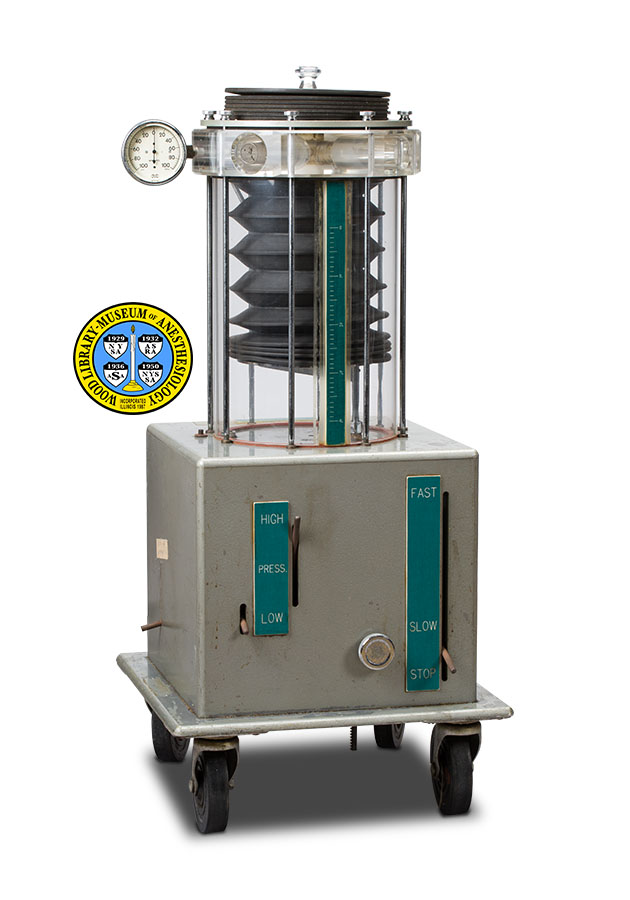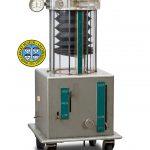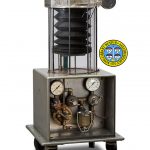Morch Surgical Respirator
Anesthesiologist and inventor Ernst Trier Morch, M.D. (1908-1996) was the first physician in Denmark to specialize in anesthesia. His introduction to anesthesiology coincided with improved techniques in thoracic (chest) surgery that called for artificial ventilation of those patients. He is noted for having fought in the Danish resistance to German occupation during WWII. He later became a strong advocate for ventilation during most inhalation anesthetics, as well as for recognition of the value of his specialty.
In 1940, he began to design his first ventilator, for use with a McKesson Nargraf anesthesia machine. He immigrated to the United States in 1949, where he continued this work during the world-wide poliomyelitis epidemic of the late 1940s and 1950s. The disease left many of its victims unable to breathe without mechanical aid. His second apparatus, the Mueller-Morch Piston Respirator, was introduced in 1954, and served patients who needed continuous ventilation. The following year he described a third apparatus, for use during inhalation anesthesia. In 1956 his fourth design was marketed as Morch Surgical Respirator. Shown here is an example of that fourth design. It was donated to the Wood Library-Museum by the inventor's daughter, Ms. Sys Trier Morch.
Catalog Record: Morch Respirator Prototype Morch Respirator
Access Key: aqkw
Accession No.: 1996-04-05-1 Q
Title: Morch respirator / [designed by Ernst Trier Morch].
Author: Mørch, Ernst Trier (1908-1996).
Corporate Author: V. Mueller & Co.
Title variation: Alt Title
Title: Morch surgical respirator.
Title variation: Alt Title
Title: Morch II surgical ventilator.
Publisher: Chicago : V. Mueller Co., [between 1955 and 1965].
Physical Description: 1 ventilator : metals, rubber, plastics ; 107 x 44 x 46 cm.
Subject: Ventilators, Mechanical.
Subject: Respiration, Artificial – instrumentation.
Note Type: General
Notes: The first year in the date range is based on the year that Dr. Morch described his third ventilator design, the Morch Solenoid Respirator. The second year in the date range is based on the date that Dr. Morch received the patent for his fourth design, the Morch Surgical Respirator.
Described form the user’s perspective. The front is considered that side on which both the pressure gauge and the bellows gauge can be read. The removable access panel is on the user’s left.
Note Type: Citation
Notes: Morch ET. Controlled respiration by means of special automatic machines used in Sweden and Denmark. Anaesthesia. March, 1948;3(1):4-10.
Note Type: Citation
Notes: Morch ET. Anaesthesi. Copenhagen: Ejnar Munksgaard 1949:333-334.
Note Type: Citation
Notes: Morch ET, Benson DW. Automatic artificial respiration during anesthesia. In: Proceedings of the third congress of the Scandinavian Society of Anesthesiologists. Aarhuus: printed by Aarhuus Stiftabogtrykkerie A/S, 1955:30-47.
Note Type: Citation
Notes: Morch ET, inventor. Respirator. US Patent 2,969,789. January 31, 1961.
Note Type: Citation
Notes: Morch ET, inventor. Piston type respirator. US Patent 3,225,758. December 28, 1965.
Note Type: Citation
Notes: Morch, Ernst Trier, (1908-1996) [biographical file]. Archives. Located at: Wood Library-Museum of Anesthesiology, Schaumburg, Illinois.
Note Type: Citation
Notes: V. Mueller & Co. A Comprehensive Guide to Purchasing Hospital-Professional Instruments-Equipment-Supplies. Chicago: V. Mueller & Co., 1956.
Note Type: Citation
Notes: Mueller Company File. Archives. Located at: Wood Library-Museum of Anesthesiology, Schaumburg, IL.
Note Type: Citation
Notes: Mushin WL, Rendell-Baker L, Thompson PW, Mapleson WW. Automatic Ventilation of the Lungs, 2nd ed. Oxford: Blackwell Scientific Publications, 1969:638-651.
Note Type: Citation
Notes: Rosenberg H, Axelrod JK. Ernst Trier Morch: inventory, medical pioneer, heroic freedom fighter. Anesth Analg. January, 2000;90(1):218-221.
Note Type: Physical Description
Notes: One ventilator; Consists of a square, metal casing with a plastic cylinder on top that houses two bellows; Mounted on a square base plate with four wheels (called a “trolley” by the inventor); The base extends beyond the casing approximately three centimeters on all four sides; The short physical description gives the depth with the front wheels turned forward and the back wheels turned backward; The depth with the wheels turned outward is approximately 44.centimeters;
The front wall of the square casing has three slots, each occupied by a metal bar that acts as a lever; To the left of center, two of these slots flank a label that reads, from top to bottom: “HIGH [new line] PRESS. [new line] LOW”; Near the right edge of this wall a third, longer slot is labeled, from top to bottom: “FAST [new line] SLOW [new line] STOP”; To the left of this third slot there is a round metal dial without markings;
The left-hand side wall bears an adhesive label that reads: “Rate of Inspiration”; There is a slot in this wall near the base and to the left of center; A metal bar that acts as a lever is seated in this slot;
The back wall consists of a removable panel that gives access to the interior of the apparatus; This panel has no features or labels;
The right-hand side wall of the casing has three round openings; The first of these openings is centered near top edge and is approximately 2.5 centimeters in diameter: The second of these openings is below and to the left of the first, and is approximately 7 centimeters in diameter; A metal connector, with the remains of red rubber tubing, obtrudes from this second opening; Above this second opening is a strip of adhesive tape on which has been written an illegible label; The third of these openings is below and to the right of the others, and is approximately 7 centimeters in diameter; Above this third opening there are the remains of another adhesive label;
A label on the top of the casing reads: “Morch Respirator”; A transparent plastic cylinder occupies the top; A rubber gasket is seated between the cylinder and the metal casing; There is a thick, transparent ring or band around the top edge of the exterior of the cylinder; This band holds four elements; The first element is a threaded round opening or port, approximately 2.75 centimeters in diameter; The second is another round opening, approximately 4 centimeters in diameter; The third is a gauge, marked, from left to right: “100, 80, 60, 40, 20, 10, 20, 40, 60, 80, 100 [new line] MM HG [new line] VAC PRESS [logo]; MARSHALTOWN [new line] IOWA, U.S.A. [new line] MFG. CO.”; The fourth element is an extruded connecting tube in which a medal rod has been fixed; A round metal plate forms the lid of the cylinder; The cylinder and plate are held in place by eight metal rods; These are inserted through small holes that pierce both the top plate of the cylinder and the plastic thick band; Each rod is threaded at top and bottom; The bottom of each rod screws into the top of the casing; Each rod is held in place by a nut on top of the metal plate;
The cylinder holds two concertina bellows made of black rubber; One of these is an ascending concertina bellows that is mounted on top of the cylinder; The other is a descending concertina bellows that is mounted inside the cylinder; Both bellows are made of black rubber; The ascending bellows has a small, clear plastic knob on top, by which it can be raised or lowered by hand; The short physical description gives the height of the object with the ascending bellows fully extended; The height of the object with the ascending bellows at rest is approximately 81.25 centimeters; A plastic gauge is fixed on the front of the cylinder; this reads, from top to bottom: “0, 1L, 2L, 3L, 4L”.
Note Type: Reproduction
Notes: Photographed by Mr. Steve Donisch, June 20, 2017.
Note Type: Acquisition
Notes: Gift of Sys Trier Morch, daughter of the inventor.
Note Type: Historical
Notes: Anesthesiologists are responsible for maintaining the patient’s respiration during surgery, and also sometimes afterwards. They may use an artificial ventilator (also called a respirator) either to assist the patient’s breathing, or to control all of the patient’s breathing. Anesthesiologist and inventor Ernst Trier Morch, M.D. (1908-1996) was the first physician in Denmark to specialize in anesthesia. His introduction to the specialty coincided with improved techniques in thoracic (chest) surgery that called for artificial ventilation of those patients. He is noted for having fought in the Danish resistance to German occupation during WWII. He later became a strong advocate for ventilation during most inhalation anesthesia, as well as for recognition of the value of his specialty in Denmark.
In 1940, he learned to operate a McKesson Nargraf anesthesia machine, and immediately began to design a new ventilator for use with it (Morch 1948, pp. 7-9, Morch & Benson 1955 p. 38 ; Rosenberg.) He later described his first ventilator as “one of the first mechanical blow-and-suck devices” ever made (Morch & Benson 1955, p. 38.) He described that ventilator at a meeting of the Royal Society of Medicine, London, in 1947. The full text of the presentation was published in 1948. He stated, in part, that the apparatus was “built upon a little trolley which can be placed away from the anaesthetic machine, to reduce explosion risk”. In a later description of the apparatus, he called it the “Morch Piston Respirator” (Morch & Benson 1955, p. 38.)
Dr. Morch immigrated to the United States in 1949, where he continued his work on ventilation. This coincided with the world-wide poliomyelitis epidemic of the late 1940s and 1950s, which struck Scandinavia especially hard, and left many victims of the disease unable to breathe without mechanical ventilation. His second apparatus was introduced in 1954. It was made by the V. Mueller Company, and called the Mueller-Morch Piston Ventilator.
In 1955, Morch and Benson described a third apparatus, called the Morch Solenoid Respirator. Mushin et al. called this third design the “Morch I Ventilator” (1969, pp. 638-640.) The third design has a hand-operated concertina bellows on top, which is placed off-center.
By 1956, a fourth design was being marketed by the V. Mueller Co., and called the Morch Surgical Respirator. It appears in advertisements, but not in the company’s 1956 catalog. The Morch Surgical Respirator has both an automatic and a hand-operated a double bellows on top and placed in the center. Dr. Morch filed to patent this fourth design in 1956, and the patent was granted in 1961. Mushin et al. called this fourth apparatus the “Morch II ‘Surgical’ Ventilator’ (1969, pp. 641-645.) The cataloged object is an example of this fourth design.
Note Type: With
Notes: Mörch ET. Controlled respiration by means of special automatic machines as used in Sweden and Denmark. Proceedings of the Royal Society of Medicine, Section of Anaesthetics. August, 1947;60(4): 603.
Note Type: Exhibition
Notes: Selected for the WLM website.



